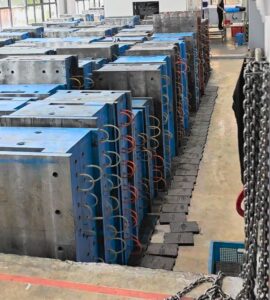In the increasingly competitive manufacturing industry today, moulds as the production of core assets, the level of its management directly determines the efficiency and profitability of the enterprise. RFID technology with automated identification, real-time data collection and intelligent analysis capabilities, has become to enhance the management of moulds, ‘tool’. Однако, to truly ‘master’ Технология RFID, need to adapt from the technology, process reconstruction and data empowerment three dimensions of the system to promote, to achieve from the ‘tools to use’ to ‘management upgrade’. The leap.
Technology adaptation: choose the right RFID programme
RFID is not a ‘plug and play’ Технология, need to be customized according to business scenarios, to avoid “not suited to the soil and water.
Hardware selection: matching the industrial environment and demand
Tag selection:
- anti-metal tags: the surface of the mould is mostly made of metal, you need to choose anti-metal RFID tags (such as ceramic packages or special adhesive backing), to ensure that the signal is stable.
- High-temperature characteristics: injection moulds need to withstand high temperatures of more than 200 ℃, need to choose high-temperature resistant tags (such as polyimide material).
Read-write deployment:
- Fixed read-write: installed at the entrance and exit of the warehouse, injection moulding machine station, to achieve automatic identification and data collection.
- Handheld terminal: used for inventory, inspection and other flexible scenarios, need to support industrial-grade protection (IP65 or above).
Системная интеграция: Open up data silos
- And MES/ERP linkage: Real-time synchronisation of RFID data to the production management system, automatic generation of work orders, updating inventory status.
- Positioning technology integration: combined with UWB or Bluetooth AoA positioning technology to achieve centimetre-level positioning of moulds (applicable to large factories).
Process reconstruction: from ‘manually driven’ to ‘system-driven’
The real value of RFID is to reshape the management process, rather than simply replace the manual records.
1.Standardise the whole life cycle management
- Инвентаризация: Bind a unique RFID code for each set of moulds and enter data such as specifications, Поставщиков, design parameters, и Ñ‚.д.. Dynamic update: Automatically update the data through readers and writers.
- Dynamic update: Automatically record the number of times used, Записи о техническом обслуживании, location changes and other information through the reader, forming a “digital resume.
2.Key Process Automation
- Intelligent Mould Adjustment: The system automatically recommends available moulds according to the production plan, and the AGV cart automatically adjusts the moulds according to the RFID positioning.
- Closed-loop maintenance: When the number of times the mould is used reaches the threshold, the system automatically triggers the maintenance work order and assigns the task.
3.Error-proofing mechanism embedded in the process
- On-machine verification: the injection moulding machine reader automatically verifies the mould ID with the work order requirements, and locks up the equipment if it does not match.
- Process Dumbness Prevention: RFID tags store the range of permissible parameters (Например. давление, Температура), the system monitors and alarms in real time.
 Data empowerment: from ’empirical decision-making’ to ‘data-driven’
Data empowerment: from ’empirical decision-making’ to ‘data-driven’
The ultimate goal of RFID is to tap the value of data to support management optimisation.
1.Data analysis: find invisible problems
- Utilisation analysis: identify high-frequency use of moulds (Например. ‘20% of moulds contribute to 80% of production capacity’), targeted expansion or optimisation of production scheduling.
- Lifetime prediction: AI analysis of the number of uses, pressure and temperature data to predict the risk of mould failure.
Continuous Optimisation: Closed-loop feedback for improvement
- Process Iteration: Based on the bottlenecks exposed by RFID data (Например, time-consuming frequent mould adjustments), optimise the warehouse layout or production scheduling.
- Cost control: through the analysis of mould wear and tear data, to develop a reasonable procurement and scrapping strategy to reduce redundant inventory.
The key to implementation: three principles to avoid ‘stepping on the pit’
- Phased promotion: start from the pilot line to verify the effect of RFID, and then gradually expand to the whole plant.
- Employee training: training technical backbone familiar with RFID system operation and maintenance, to avoid ‘technology idle’.
- Vendor collaboration: Select RFID service providers with experience in industrial scenarios to provide tag installation, system commissioning and other full-cycle support.
Дело: a home appliance enterprises ‘master RFID’ practice
Pain points: mould transfer rely on manual, find the mould time accounted for 40% of the production preparation, annual maintenance costs of more than 2 миллионов юаней.
Решение:
- Для 300 sets of moulds to install anti-metal RFID tags, deployment of fixed readers and positioning system.
- Integrate with MES system to achieve automation of mould adjustment and intelligent maintenance.
Achievements:
- Mould finding time reduced by 75%, annual maintenance cost reduced by 40%.
- Through data optimisation scheduling, production capacity increased by 12%.






